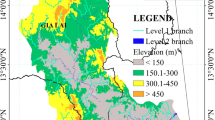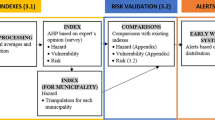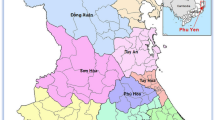Abstract
This study focuses on measuring the spatial nature of drought risk which is conceived as the product of drought severity, drought vulnerability, and drought exposure in the Purulia district, located in the eastern part of the Indian peninsula. Drought severity is measured using the Standard Precipitation Index and drought vulnerability is calculated as the average condition of meteorological, hydrological, agricultural, and socio-economic drought. The drought types and drought exposure conditions are the outcome of multi-criteria analysis where the Fuzzy Analytical Hierarchy Process is used for assigning weights to the respective parameters and the Analytical Hierarchy Process is used for determining the class ranks. 31.46% of the total district area has registered moderate to high and high vulnerability to drought situations, while 16.57% of the entire district area has been found moderate to high and highly exposed to drought situations. Similarly, 39.39% of the district’s total area is under a significant drought risk. Blocks like Barabazar (75.49%), Jhalda-I (71.85%), and Purulia-II (52.66%) have the majority of their area under extreme drought risk conditions. The modeled outcome of drought vulnerability was found significant while being tested with phenomena highly correlated to drought events, land surface temperature, and aridity index. The computed spatial profile of the districts’ drought risk condition is of substantial help for the policymakers in preparing effective drought mitigation measures to restrict drought impacts reasonably.








Similar content being viewed by others
Data availability
The authors hereby confirm that no third party or previously published data has been used in this project. All the secondary sources of data being used have been properly mentioned within the manuscript. The authors have all the rights to make the data available upon request.
References
Aadhar, S., & Mishra, V. (2022). Challenges in drought monitoring and assessment in India. Water Security, 16, 100120.
Arabameri, A., Chandra Pal, S., Santosh, M., Chakrabortty, R., Roy, P., & Moayedi, H. (2022). Drought risk assessment: Integrating meteorological, hydrological, agricultural and socio-economic factors using ensemble models and geospatial techniques. Geocarto International, 37(21), 6087–6115.
Bageshree, K., & Kinouchi, T. (2022). A multivariate drought index for seasonal agriculture drought classification in semiarid regions. Remote Sensing, 14(16), 3891.
Bera, A., & Das, S. (2021). Water resource management in semi-arid Purulia district of West Bengal, in the context of sustainable development goals. In Groundwater and Society (pp. 501–519). Springer, Cham.
Bera, B., Shit, P. K., Sengupta, N., Saha, S., & Bhattacharjee, S. (2021). Trends and variability of drought in the extended part of Chhota Nagpur plateau (Singbhum Protocontinent), India applying SPI and SPEI indices. Environmental Challenges, 5, 100310.
Bhunia, P., Das, P., & Maiti, R. (2020). Meteorological drought study through SPI in three drought prone districts of West Bengal. India. Earth Systems and Environment, 4(1), 43–55.
Biswas, A. (2019). Prevailing aquaculture practices in a drought-prone landscape: A case of Purulia district of West Bengal. India. Age, 18(30), 2–3.
Budyko, M. I. (1974). Climate and life (p. 507). Academic Press, New York.
Byun, H. R., & Wilhite, D. A. (1999). Objective quantification of drought severity and durationJournal of Climate., 12(1999), 2747–2756.
Census of India (2011). District Census Handbook of Purulia. Retrieved from https://censusindia.gov.in/nada/index.php/catalog/1354.
Cruz, M. G., Hernandez, E. A., & Uddameri, V. (2021). Vulnerability assessment of agricultural production systems to drought stresses using robustness measures. Scientific Reports, 11(1), 21648.
Das, B., Pal, S., Malik, S., & Chakrabortty, R. (2018). Modeling groundwater potential zones of Puruliya district, West Bengal, India using remote sensing and GIS techniques. Geology, Ecology, and Landscapes, 3, 1–15. https://doi.org/10.1080/24749508.2018.1555740
Ghosh, K. G. (2016). Long range climatic variability over Birbhum district, West Bengal and their impact on rainfed Aman crop in the context of climate change: Adoption and mitigation. In Rural Health, Women Empowerment and Agriculture: Issues and Challenges, Chap 21, ed. P.K. Chattopadhyay and D.S. Kushwaha, 1st ed., 277–298. India: New Delhi Publishers.
Glenn, E. P., Scott, R. L., Nguyen, U., & Nagler, P. L. (2015). Wide-area ratios of evapotranspiration to precipitation in monsoon-dependent semiarid vegetation communities. Journal of Arid Environments, 117, 84–95.
Government of West Bengal (2021). Child Risk and Impact Analysis (CRIA, 2018). Office of the District Magistrate, Purulia. Retrieved from https://wbxpress.com/files/2021/05/Purulia.pdf.
Government of West Bengal (2011). District Statistical Handbook of Purulia, 2010 and 2011 combined. Retrieved from http://wbpspm.gov.in/publications/District%20Statistical%20Handbook.
Government of West Bengal (2021). District Disaster Management Report (2020–21) of Purulia. Office of the District Magistrate, Purulia. Retrieved from https://wbxpress.com/files/2021/05/Purulia.pdf.
Government of West Bengal. (2021). Draft District Disaster Management Plan, Purulia 2020–2021. Disaster Management Section, Purulia, West Bengal: Office of District Magistrate.
Guo, Y., Huang, S., Huang, Q., Wang, H., Fang, W., Yang, Y., & Wang, L. (2019). Assessing socioeconomic drought based on an improved Multivariate Standardized Reliability and Resilience Index. Journal of Hydrology, 568, 904–918.
Hagenlocher, M., Meza, I., Anderson, C. C., Min, A., Renaud, F. G., Walz, Y., & Sebesvari, Z. (2019). Drought vulnerability and risk assessments: State of the art, persistent gaps, and research agenda. Environmental Research Letters, 14(8), 083002.
Hoque, M. A. A., Pradhan, B., & Ahmed, N. (2020). Assessing drought vulnerability using geospatial techniques in northwestern part of Bangladesh. Science of the Total Environment, 705, 135957.
Hoque, M. A. A., Pradhan, B., Ahmed, N., & Sohel, M. S. I. (2021). Agricultural drought risk assessment of Northern New South Wales, Australia using geospatial techniques. Science of the Total Environment, 756, 143600.
IPCC: Intergovernmental Panel on Climate Change. (2007). Climate change 2007: The physical science basis. In S. Solomon, D. Quin, M. Manning, X. Chen, M. Marquis, K. B. Averyt, H. L. Tignor, & M. Miller (Eds.), Contribution of working group I to the fourth assessment report of the intergovernmental panel on climate change (pp. 1–996). Cambridge University Press.
Joshi, K. (2019). The impact of drought on human capital in rural India. Environment and Development Economics, 24(4), 413–436.
Jun, K. S., Chung, E. S., Kim, Y. G., & Kim, Y. (2013). A fuzzy multi-criteria approach to flood risk vulnerability in South Korea by considering climate change impacts. Expert Systems with Applications, 40(4), 1003–1013. https://doi.org/10.1016/j.eswa.2012.08.013
Kar, S. K., Thomas, T., Singh, R. M., & Patel, L. (2018). Integrated assessment of drought vulnerability using indicators for Dhasan basin in Bundelkhand region. Madhya Pradesh, India. https://doi.org/10.18520/cs/v115/i2/338-346 .
Lin, Q., Wu, Z., Singh, V. P., Sadeghi, S. H. R., He, H., & Lu, G. (2017). Correlation between hydrological drought, climatic factors, reservoir operation, and vegetation cover in the Xijiang Basin, South China. Journal of Hydrology, 549, 512–524.
McKee, T. B., Doesken, N. J., & Kleist, J. (1995). Drought monitoring with multiple time scales. Ninth Conference on Applied Climatology (pp. 233–236). Dallas TX: American Meteorological Society.
Mehran, A., Mazdiyasni, O., & AghaKouchak, A. (2015). A hybrid framework for assessing socioeconomic drought: Linking climate variability, local resilience, and demand. Journal of Geophysical Research: Atmospheres, 120(15), 7520–7533.
Mohan, K., Ramasamy, A. & Varghese, J. (2021). Drought severity assessment using automated land surface temperature retrieval technique. Arabian Journal of Geosciences, 14, 2358. https://doi.org/10.1007/s12517-021-08672-1.
Mooley, D. A., & Parthasarathy, B. (1984). Indian Summer Monsoon and El Nino. Pure and Applied Geophysics, 121, 339–352. https://doi.org/10.1007/BF02590143
Nath, R., Nath, D., Li, Q., Chen, W., & Cui, X. (2017). Impact of drought on agriculture in the Indo-Gangetic Plain. India. Advances in Atmospheric Sciences, 34(3), 335–346.
Palmer, W. C. (1968). Keeping track of crop moisture conditions, nationwide: The new crop moisture index. Weatherwise, 21, 156–161. https://doi.org/10.1080/00431672.1968.9932814
Pandey, S., Bhandari, H., & Hardy, B. (2007). Economic costs of drought and rice farmers’ coping mechanisms: A cross-country comparative analysis (p. 203). Los Baños (Philippines): International Rice Research Institute.
Prabhakar, S. V. R. K., & Shaw, R. (2008). Climate change adaptation implications for drought risk mitigation: A perspective for India. Climatic Change, 88(2), 113–130.
Radulović, M., Brdar, S., Mesaroš, M., Lukić, T., Savić, S., Basarin, B., & Pavić, D. (2022). Assessment of groundwater potential zones using GIS and Fuzzy AHP techniques—A case study of the Titel Municipality (Northern Serbia). ISPRS International Journal of Geo-Information, 11(4), 257.
Raha, S., & Gayen, S. K. (2021). Comparative study of different exponential smoothing models in simulation of meteorological drought: A study on Purulia district, West Bengal, India. Journal of Applied and Natural Science, 13(2), 504–511.
Rao, N., Sarma, P. B. S., & Chander, S. (1988). A simple dated water-production function for use in irrigated agriculture. Agricultural Water Management., 13, 25–32.
Reddy, G. S., Prabhu, C. N., Kamepalli, L. B., & Jagadeesh, S. (2021). Effect of drought on development of children: Field observations from the drought-prone district of Deccan Plateau of Southern India. In Economic Effects of Natural Disasters, 359–372. Academic Press.
Roy, S., & Hazra, S. (2020). Monthly drought assessment and early warning for Droughts in Purulia district of West Bengal. Indian Ground Water, XV.
Roy, S. S., & Jana, N. C. (2019). Agricultural productivity and efficiency in Purulia district. West Bengal. Crops, 198, 81.
Saha, U. D., & Bhattacharya, S. (2020). Application of multi-criteria decision-making approach for ascertaining the avulsion potentiality of the Torsa River course. Modeling Earth System and Environment. https://doi.org/10.1007/s40808-020-00967-8 .
Saranya, P., Krishnakumar, A., Kumar, S., & Krishnan, K. A. (2020). Isotopic study on the effect of reservoirs and drought on water cycle dynamics in the tropical Periyar basin draining the slopes of Western Ghats. Journal of Hydrology, 581, 124421.
Senapati, N., Halford, N. G., & Semenov, M. A. (2021). Vulnerability of European wheat to extreme heat and drought around flowering under future climate. Environmental Research Letters., 16(2021), 024052.
Shah, R., Bharadiya, N., & Manekar, V. (2015). Drought index computation using Standardized Precipitation Index (SPI) method for Surat District, Gujarat. Aquatic Procedia, 4, 1243–1249.
Shahid, S., & Behrawan, H. (2008). Drought risk assessment in the western part of Bangladesh. Natural Hazards, 46, 391–413.
Sharma, K. D. (2011). Rain-fed agriculture could meet the challenges of food security in India. Current Science, 100(11), 1615–1616.
Shen, Q., Zhang, L. D., Liao, Z. H., Wang, S., Yan, T. X., Shi, P., et al. (2018). The genome of Artemisia annua provides insight into the evolution of Asteraceae family and artemisinin biosynthesis. Moleculer Plant, 11(6), 776–788. https://doi.org/10.1016/j.molp.2018.03.015
Simelton, E., Fraser, E. D., Termansen, M., Forster, P. M., & Dougill, A. J. (2009). Typologies of crop-drought vulnerability: An empirical analysis of the socio-economic factors that influence the sensitivity and resilience to drought of three major food crops in China (1961–2001). Environmental Science & Policy, 12(4), 438–452.
Singh, M. B., Fotedar, R., Lakshminarayana, J., & Anand, P. K. (2006). Studies on the nutritional status of children aged 0–5 years in a drought-affected desert area of western Rajasthan. India. Public Health Nutrition, 9(8), 961–967.
Speich, M. J. (2019). Quantifying and modeling water availability in temperate forests: A review of drought and aridity indices. Iforest, 12(1), 1–16.
Thomas, T., Jaiswal, R. K., Galkate, R., Nayak, P. C., & Ghosh, N. C. (2014). Drought indicators-based integrated assessment of drought vulnerability: A case study of Bundelkhand droughts in central India. https://doi.org/10.1007/s11069-016-2149-8 .
United Nations Environment Programme (UNEP) (1992). World Atlas of Desertification.
Vicente-Serrano, S. M., Beguería, S., & López-Moreno, J. I. (2010). A Multi-scalar drought index sensitive to global warming: The standardized precipitation evapotranspiration index–SPEI. Journal of Climate, 23, 1696–1718.
Wang, W., Ertsen, M. W., Svoboda, M. D., & Hafeez, M. (2016). Propagation of drought: From meteorological drought to agricultural and hydrological drought. Advances in Meteorology.
WBSAPCC: West Bengal State Action Plan on Climate Change. (2010). Govt. of West Bengal, India. http://moef.nic.in/downloads/public-information/WestBengal-SAPCC.pdf.
Wilhelmi, O. V., & Wilhite, D. A. (2002). Assessing vulnerability to agricultural drought: A Nebraska case study. Natural Hazards, 25, 37–58.
Wilhite, D. A., & Glantz, M. H. (1985). Understanding: The drought phenomenon: The role of definitions. Water International, 10(3), 111–120.
Xu, H. (2005). Modification of normalised difference water index (NDWI) to enhance open water features in remotely sensed imagery. International Journal of Remote Sensing. https://doi.org/10.1080/01431160600589179
Zeng, Z., Wu, W., Li, Z., Zhou, Y., Guo, Y., & Huang, H. (2019). Agricultural drought risk assessment in Southwest China. Water, 11(5), 1064.
Zhang, Q., Sun, P., Li, J., Xiao, M., & Singh, V. P. (2015). Assessment of drought vulnerability of the Tarim River basin, Xinjiang. China. Theoretical and Applied Climatology, 121(1), 337–347.
Zhang, Q., Sun, P., Li, J., Xiao, M., Singh, V. P. (2014). Assessment of drought vulnerability of the Tarim River basin, Xinjiang, China. Theoretical Applied Climatology. https://doi.org/10.1007/s00704-014-1234-8
Zhang, Q., Zhang, W., Chen, Y. D., & Jiang, T. (2011). Flood, drought andtyphoon disasters during the last half century in the Guangdong province, China. Natural Hazards, 57(2), 267–278.
Zhou, R., Jin, J., Cui, Y., Ning, S., Bai, X., Zhang, L., & Tong, F. (2022). Agricultural drought vulnerability assessment and diagnosis based on entropy fuzzy pattern recognition and subtraction set pair potential. Alexandria Engineering Journal, 61(1), 51–63.
Acknowledgements
The study did not receive any funds to acknowledge. However, we would acknowledge the data support provided by NASA, Geological Survey of India, United States Geological Survey, and Earth Explorer along with the free online platform of Google Earth Engine to apply different techniques for geospatial analysis.
Author information
Authors and Affiliations
Contributions
Upali Baral was engaged in designing, data curation, and computation required for this research. Ujwal Deep Saha was responsible for the conception, supervision, preparing the write-up and theoretical formalism required for this research. While Uttam Mukhopadhyay and Dharmaveer Singh were responsible for supervision and theoretical formalism required for this research.
Corresponding author
Ethics declarations
Ethical standards
APA ethical standards were followed in the conduct of the study.
Competing interests
The authors declare no competing interests.
Additional information
Publisher's Note
Springer Nature remains neutral with regard to jurisdictional claims in published maps and institutional affiliations.
Supplementary Information
Below is the link to the electronic supplementary material.
Rights and permissions
Springer Nature or its licensor (e.g. a society or other partner) holds exclusive rights to this article under a publishing agreement with the author(s) or other rightsholder(s); author self-archiving of the accepted manuscript version of this article is solely governed by the terms of such publishing agreement and applicable law.
About this article
Cite this article
Baral, U., Saha, U.D., Mukhopadhyay, U. et al. Drought risk assessment on the eastern part of Indian peninsula—a study on Purulia district, West Bengal. Environ Monit Assess 195, 1364 (2023). https://doi.org/10.1007/s10661-023-11920-4
Received:
Accepted:
Published:
DOI: https://doi.org/10.1007/s10661-023-11920-4





